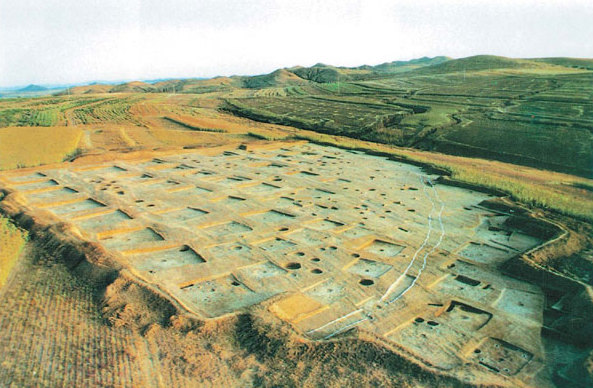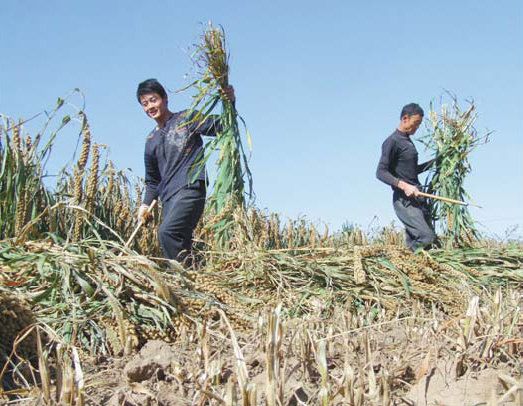Seeds of hope
Updated: 2013-08-28 07:59
By Wang Kaihao (China Daily)
|
||||||||

|
The excavation site at Xinglongwa village, Aohan Banner, the Inner Mongolia autonomous region is considered the birthplace of dryland farming. Provided to China Daily |
Ancient millet varieties from an arid swathe of Inner Mongolia could provide food security as growing water shortages threaten agriculture globally. Wang Kaihao reports in Aohan Banner, Inner Mongolia.
While many farmers are struggling to go organic, Aohan Banner's agrarians have no choice.
But that has also won them a United Nations designation for agricultural heritage and offers potential solutions to food crises.
The sandy dryland - created by annual rainfall ranging from 310 to 460 mm, and punctuated by frequent droughts - and undulating topography in the east of the Inner Mongolia autonomous region's Chifeng city makes mechanized farming impossible.
Farmers plant much in the way they have for millennia.

More than 1,400 grains of millet dating to about 7,650 years ago were discovered during a 1980s excavation in the banner's Xinglongwa village.
It's the world's oldest and largest-scale millet production site ever discovered, Institute of Archeology at Chinese Academy of Social Sciences researcher Zhao Zhijun says.
The site's also hailed as the birthplace of dryland farming.
The United Nation's Food and Agriculture Organization listed Aohan's drylands among the Globally Important Agricultural Heritage Systems in September 2012.
It joined 25 "remarkable land use systems and landscapes, which are rich in globally significant biological diversity evolving from the co-adaption of community with its environment and its needs and aspirations for sustainable development". Eight of the sites are in China.
Cultivation by hand
In such places as Zhasaiyingzi village, humans and livestock cultivate the yellow millet that bristles on terraced slopes.
Farmers strictly adhere to the Chinese lunar calendar. If it rains before April, they plant corn. If it rains before late June, they plant millet. If aridity persists, they plant buckwheat.
Shi Xiuzhen says she has known this rule of thumb all her life. The 51-year-old has followed it every year, without wondering why.
Scientists have determined local ancestral wisdom boosts harvests, even during severe droughts.
"Rainfalls before April indicate more precipitation will fall that cultivation season, so corn is planted because it needs more water than millet," deputy director of the banner's agricultural bureau Xu Feng says.
"Buckwheat can survive with almost no water."
There are 21 kinds of miscellaneous grains grown on more than 660 hectares belonging to the Huilong Agricultural Cooperative. The cooperative is the larger of Aohan's two organic farming bases. It expanded from 330 total hectares last year to 800.
"We want to use more modern methods but are often forced to maintain traditions," cooperative manager Kong Fanjun says.
Seeding machines can't be used on slopes steeper than 15 degrees. So half of Aohan's 27,000 hectares of millet are cultivated in traditional ways.
Traditional - and organic
But old farming techniques are winning new appeal.
"Urbanites want organic food," says Shi, who's a cooperative member.
"These crops are popular. And we save by not buying chemical fertilizers, herbicides and pesticides."
Three donkeys plow her fields. She uses lights and organic insect repellents.
The sheep she raises bring in 50,000 yuan ($8,170) a year, plus manure.
One hectare can produce 3,700 kilograms of organic millet and up to 6,000 kg if chemicals are used. But the price is higher for greener goods. Last year, 1 kg of ordinary millet sold for 3.6 yuan in the local market, while organic varieties sold for 2 yuan more.
Shi's family earned nearly 50,000 yuan from millet last year - 10,000 yuan more than before she switched to organic in 2007.
Kong, the cooperative manager, says 1 kg sells for about 20 yuan once processed and put in gift packages.
Annual sales of the cooperative topped 10 million yuan last year, he estimates. Most produce was sold to Beijing and northeastern provinces.
"Prices will go up as more people become health conscious," he says.
Grain varieties threatened

But while Aohan's ancient farming methods will likely survive, its grain varieties may not, Xu from the agricultural bureau says.
"Dozens of delicious and exceptionally adaptable breeds have been grown by individual farmers in limited amounts for generations," he says.
"But they're the farmers' food. They aren't sold, because the yield per unit of land is small. Farmers are giving up on growing them because of their low market value. We're on the verge of losing these agricultural legacies."
The bureau plans to launch a general survey and a species database during the September harvest. It will work with enterprises to bring these crops to high-end markets.
"Perhaps these could resolve concerns about genetically modified food, promote better farming methods and breed better varieties," Xu says. "Many areas in the world are arid, and exacerbating water shortages are creating a global bottleneck to agricultural development.
"Since ancient times, millet has been used to provide food security during natural disasters. We can continue this legacy, today."
Contact the writer at wangkaihao@chinadaily.com.cn.
|
Farmers harvest millet in Aohan Banner. Provided to China Daily |
(China Daily USA 08/28/2013 page8)

 Five apps to help you 'breathe' in Beijing
Five apps to help you 'breathe' in Beijing
 Wozniacki survives battle with Chinese qualifier
Wozniacki survives battle with Chinese qualifier
 Moscow air show opens with flight demonstrations
Moscow air show opens with flight demonstrations
 US preparing for probable strike on Syria
US preparing for probable strike on Syria
 Putting money on full moon
Putting money on full moon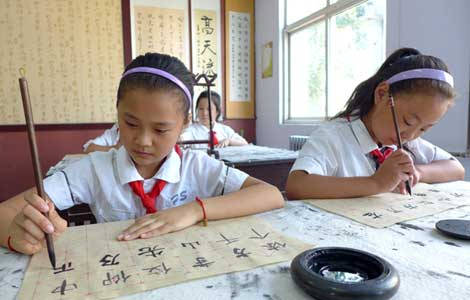
 Language list aims to pass on Chinese culture
Language list aims to pass on Chinese culture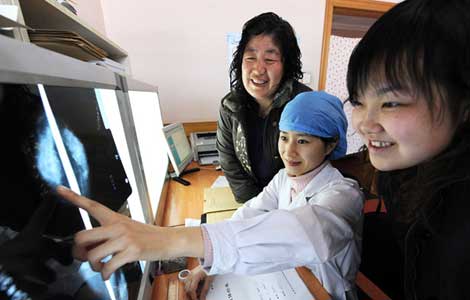
 Cancer patient delivers healthy baby
Cancer patient delivers healthy baby
 Chinese navy starts escort mission at Gulf of Aden
Chinese navy starts escort mission at Gulf of Aden
Most Viewed
Editor's Picks

|
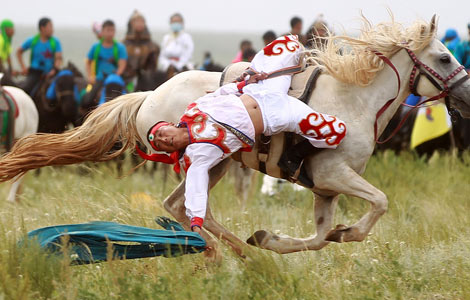
|

|

|

|

|
Today's Top News
US envoy to visit DPRK to secure prisoner's release
US 'must consider impact' of winding down QE
China gearing up for plenary session
Japan suspends rocket launch at last minute
Global expertise a scarce asset for employers
Sino-Japanese meeting at G20 ruled out
New time limits for visa processing
Trending news across China
US Weekly

|

|
